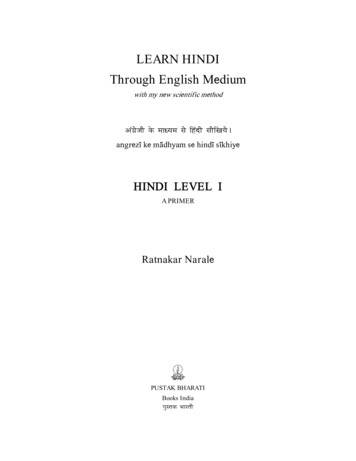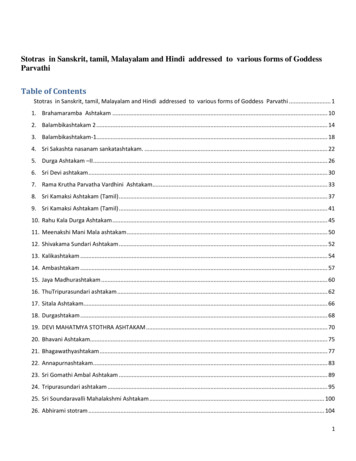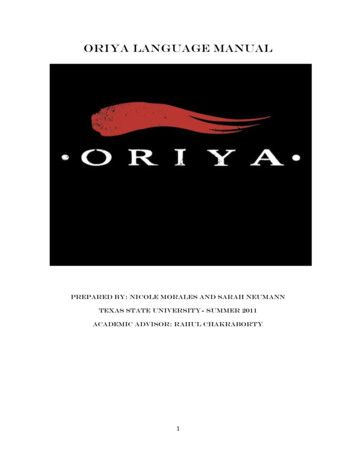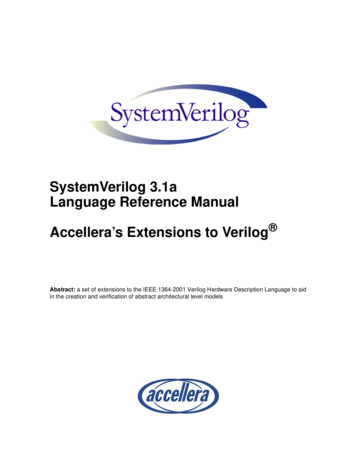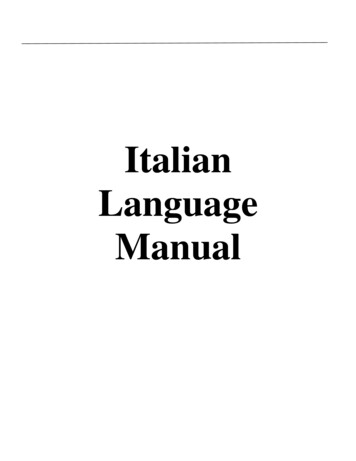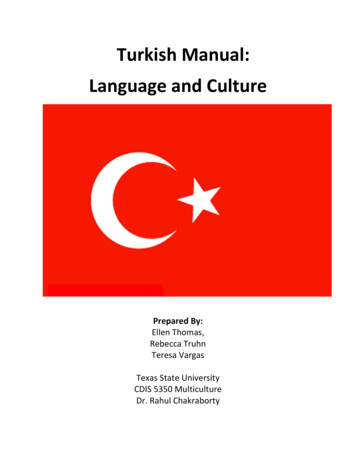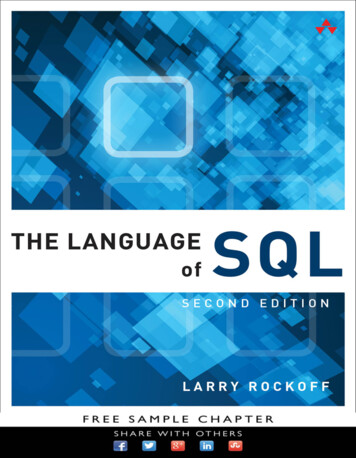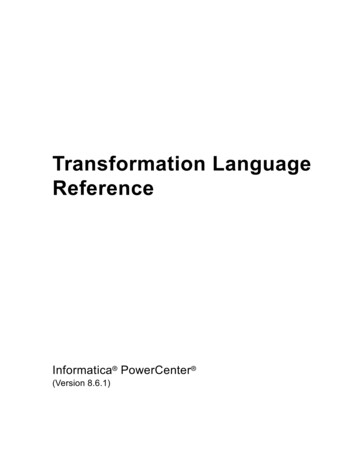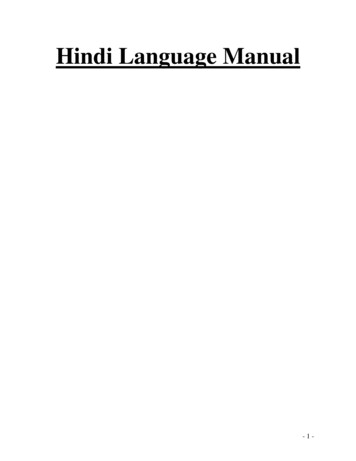
Transcription
Hindi Language Manual-1-
Table of ContentsPage 1, 2 – Linguistic CommunityPage 3 & 4 – Social AspectsPage 5 – Home RemediesPage 6, 7 – Geographic Distribution of the LanguagePage 8 – Population in the USAPage 9, 10, 11, 12 – Linguistic Features (Phonology, Morphology, Syntax, Semantics,Pragmatics)Page 13, 14, 15 – Basic Hindi WordsPage 16 – Health FactorsPage 17 – Indian CuisinePage 18 – Assessment in HindiPage 19 – Common Pronunciation ErrorsPage 20, 21, 22, 23 – Journal ArticlesPage 24 – Online Hindi ResourcesPage 25 – SLPs in Texas with Hindi Language backgroundPage 26 – Cultural Do’s & Don’tsPage 27, 28, 29 – Case HistoryLinguistic Community of India-2-
The Constitution of India has advised the usage of Hindi and English to be the twoofficial languages of communication for the Union Government.There are over 1 million persons born from India in the United States and over half livein just five states. The Indian foreign born from India make up less than 1 percent of thetotal U.S. population. Immigrants from India make up .4% of the total U.S. population.According to Census 2000, California had the largest number of foreign born from Indiawith 198,201, New Jersey in second with 119,491, and New York with 117,238The remaining 10 states with the largest number of immigrants from India include Illinois(83,916), Texas (78,388), Pennsylvania (37,541), Michigan (36,323), Florida (32,295),Maryland (32,276), and Virginia (30,611). Idaho, Oregon, and Colorado have the largestgrowth of the Indian population according to the 2000 U.S bureau.The Hindi languages predominate in the Indian states and Union Territories of Bihar,Chhattisgarh, Delhi, Haryana, Himachal Pradesh, Jharkhand, Madhya Pradesh,Rajasthan, Uttar Pradesh and Uttarakhand.According to the 2001 census of India, Hindi is the mother tongue of about 422 millionIndians, or about 40% of India's population.Outside India, Hindi speakers number around 8 million in Nepal, 890,000 in SouthAfrica, 685,000 in Mauritius, 317,000 in the U.S., 233,000 in Yemen, 147,000 inUganda, and about 30,000 in Germany.There are two different dialects of the Hindi language: Eastern Hindi and Western Hindi.THE HINDI BELT:The following graph represents the number of residents who speak Hindi/Urdu as their mothertongue.-3-
Persons who returned the language as their mother 4,941,43543,406,93251,536,111Social Aspects-4-
ReligionHindi is a language. Hinduism is a religion, and its believers are called ―Hindus.‖ Not all Hindusspeak Hindi, and not all Hindi-speakers are Hindus. There are approximately 827 millionHindus,of the world population making Hinduism the third largest religion in the world afterChristianity and htmReligious CompositionPopulation 55,2070.8Jains4,225,0530.4Other Religions & 0Religion not statedTotal *Religious and philosophical works were written in Hindi along with other languages.Hinduism, its religious doctrines, traditions and observances are very typical and inextricablylinked to the culture and demographics of India. Hinduism has one of the most ethnicallydiverse bodies of adherents in the world. Hinduism can be seen as a ―way of life‖ because ofthe many civilized forms of the ex.htmlSome common traditions of the Hindu religion include:o Fasting: do not eat meat and only live on fruits and milk. Some people fast todevelop a strong bond with a Supreme Being. Another purpose of fasting is toodevelop discipline within the followers and/or for body cleansing. Fasting is notrequired among all Hindus but can be seen as a way of life.o Marriage: Wedding ceremonies and rituals vary within all Hindus. Althoughmarriage arrangement and approval by family members was common severalyears ago, it is not necessary and is becoming obselete in today’s society. Hindumarriage ceremonies are very colorful and elaborate. Families of the bride and thegroom hold numerous festivities to celebrate the wedding.o Death: Upon the death of a Hindu person, his or her body is ceremonially bathedand wrapped in clean, mostly white cloth called khadi. Burial is decided uponfamily traditions. Some Hindu believe bodies should be cremated and ashesthrown in Holy Rivers within three days, however, some Hindus will bury thedead (http://womennewsnetwork.net).o Bindi and decoration: A bindi is placed between the eye brows to concealwisdom. It is said to retain energy and strength and protect against demonds.-5-
Married women wear a vermilition mark in the part of their hair to as a symbol oftheir marital status .html).o Karma: is a law of behavior and consequences in which actions in past live(s)affects the circumstances in which one is born and lives in this life.o A variety of different religious festivals can be found .Respect For Elderso A host of words are used to show respect and politeness in the Hindi/Urdulanguage. These words are used with people who are older in age or with whomyou are not acquainted. For example the English word 'you' can be translated intothree words in Urdu 'tu' (informal, extremely intimate, or derogatory) 'tum'(informal) and 'aap' (formal and respectful). Respect is highly valued andchildren are taught to be respectful of all elders, whether it is grandparents,siblings, teachers, or family friends. Discipline of children is thought to comenaturally in order to teach children right from wrong.Health Benefitso Health beliefs and remedies depend on family and cultural traditions and beliefs.A traditional medicine is called Ayurveda which is an ancient system of healthcare that is native to the Indian subcontinent. Even today it is very common inIndia, Nepal, and Sri Lanka and is used by millions of people.o Hindus and Sikhs believe in reincarnation. The soul is immortal and the humanbody is physical and superficial. This belief influences their attitude towardstreatment of serious illness to the extent that the patient or family members areresigned to let fate determine the outcome of the illness.o Those who are ill are well attended to and supported by family, relatives andfriends.o Doctors are looked up to and enjoy respect and trust. This places greatresponsibility and expectations on the doctor. In a serious illness, the familydesperately believes that the doctor has the power to save the life of loved one.Common Natural RemediesBotanical NameCommon NameUse-6-
Andriograohis paniculataKing of BittersHepatoprotectiveBoswellia serrataOlibanum, Farnk incenseAntiarthritic,AntihyperlipidCassia angustifiliaIndian sennsLaxativeColeus forskohliiColeusAntiobesityGarcinia camogia, CalciumGarcinia, KokumAntiobesityGarcinia cambogio,PotassiumGarcinia, KokumAntidiabeticGynema sylvestrisGymnemaAphrodisiac, AntioxidantShilajitAsphaltPotent AphrodisiacTribulus terrestrisPuncture vinePotent AphrodisiacTaxus baccataHimalayanTaxol, Ovarian cancer Child rearingo A common practice of traditional Indian culture that has also influenced the health of thewomen in this population is the young age at which many girls are married. In the 1991census report from India, the percentage of married women age 15-19 years is 35%.Childbearing during the adolescent years poses significant health risks to both the motherand the infant, especially if the mother is poorly nourished.o Many Indian women view pregnancy as a time of increased body heat. They believe thatbeing out in the sun or overheating will cause a miscarriage. Women who have this beliefavoid food hot in temperature.o Morning sickness is thought to be caused by an increase in body heat or pitta, a termmeaning bile. It is associated with nausea, dizziness and overheating of the body.o A male gendered baby is preferred. The sex of the baby is not revealed to the motheruntil after the placenta is removed to not emotionally distress the mother. When thegender is revealed, the family must be accepting of the babies sex.Geographical Distribution of the LanguagePOPULATION OF HINDUS IN THE U.S.:-7-
From 1,700 people in 1900, the Hindu population in America grew to approximately 387,000 by1980 and 1.1 million in 1997. Currently, the estimated U.S. population of Hindus of Indianorigin is approximately 2 million (1.8 million Indian and 200,000 Indo-Caribbean).Demography spoken predominantly in northern and central India (the "Hindi belt")Native speakers of Hindi dialects between them account for 41% of the Indian population(2001 Indian census).The present day nomenclature/term of Hindi language includes 49 mother tongues, creating astatistical majority. Different mother tongues are combined to make a linguistic majority. It is themother tongue of 22% of the population; it has 20.22% of mother tongues clustered under it as alanguage. It is used as a second language by 6.16%, and as a third language by 2.60%, totaling to50.98% of the entire population of India. Hindi crosses the magic figure of the definition ofmajority, a language with more than 50% of the population of India, in the 1991 Census.The table given below will give a Glimpse of growth of Hindi print media in the 20012507205892002341022067Name of the PublicationReadership(in'lakhs)-8-
1Dainik Bhaskar (Hindi)157.09'2Dainik Jagran (Hindi)149.853Daily Thanthi (Tamil)100.944Eenadu (Telugu).094.585Malayala ManoramaMalayalam)087.986086.40Amar Ujala (Hindi)7078.99Hindustan (Hindi)8078.67Lokmat (Marathi)9076.46Mathrubhumi (Malayalam)10074.19Times of India raphy of pulation in USA-9-
In the year 2002, of the entire total 1,063,732 legal immigrants to USA from all the countries, asmany as 66,864 were from India. According to the US census, the overall growth rate for Indiansfrom 1990 to 2000 was 105.87 %. The average growth rate for the whole of USA was only 7.6%.16.4 % of the Asian-American community are comprised on Indians. In 2000, of all the foreignborn population in USA, Indians were 1.007 million. Their percentage was 3.5 %. From 2000onwards the percent rate and the growth rate of Indians amongst all the immigrants has increasedby over 100 %.Between 1990 and 2000, the Indian population in the US grew 130%, which is 10 times thenational average of 13%. Source: US Census BureauCurrently, Indian Americans are the third largest Asian American ethnic group followingChinese Americans and Filipino Americans.One in every twenty-six Indians in the US is a millionaire, comprising 10% of US millionaires.Source: 2003 Merrill Lynch SA Market StudyIndians have one of the highest educational qualifications of all ethnic groups in the US.Nearly 67% of all Indians have a bachelor’s or high degree (compared to 28% nationally and44% average for all Asian American groups).Nearly 40% of all Indians in the United States have a master’s, doctorate or other professionaldegree, which is five times the national average. Source: The Indian American Centre forPolitical di.htmLinguistic Features –Phonology, Morphology, Syntax, Semantics, Pragmatics- 10 -
Hindi vs. UrduHindi is contrasted with Urdu in the following two ways: 1) way they are written, 2) the use ofSanskrit vocabulary in higher registers. Hindi looks to the classical language of Sanskrit for itshigher vocabulary, script and general cultural orientation, while Urdu looks to Persian andArabic for these things. To a common unbiased person, Hindi and Urdu are virtually identical. .PhonologyHindi is written in Devanagari script. The script is written from left to right and has no capitalletters.Consonants: Hindi/Urdu has a core set of 28 consonantsSupplementing these are 2 consonants that are internal developments in specific wordmedial contexts7 consonants originally found in loan words, whose expression is dependent on factorssuch as status (class, education, etc.) and cultural register (Modern Standard Hindi vsUrdu).Most native consonants may occur geminate (i.e. and is typically doubled in length;exceptions are /bʱ, ɽ, ɽʱ, ɦ/). Geminate consonants are always medial and proceeded by one of the interior vowels (that is, /ə/, /ɪ/, or /ʊ/).For an English speaker, a notable feature of the Hindi/Urdu consonants is that there is afour-way distinction of phonation among plosives, rather than the two-way distinctionfound in English. The phonations are tenuis (i.e a stop or affricate that is not voiced,aspirated, glottalized), as /p/, voiced, as /b/, aspirated, as /pʰ/, and murmured, as /bʱ/. Stops in final position are not released; /ʋ/ varies freely as [v], and can also bepronounced [w]; /ɾ/ can surface as a trill [r], and geminate /ɾː/ is always a trill.[9] Thepalatal and velar nasals [ɲ, ŋ] occur only in consonant clusters with a followinghomorganic stops, as allophones of nasal vowels followed by a stop, and in Sanskritloanwords.[8][9] There are murmured sonorants, [lʱ, ɾʱ, mʱ, nʱ], but these are considered tobe consonant clusters with /ɦ/ in the analysis adopted by Ohala (1999).Hindi-Urdu phonology- 11 -
BilabialmNasalPlosiveLabio- Dental/Post-alv./RetroflexVelar Glottaldental AlveolarPalataln(ɳ)btdʈɖk gpʰ bʱtʰdʱʈʰɖʱkʰ gʱpFricativetʃʰ dʒʱfsʋʃzɾTap or /en.wikipedia.org/wiki/Hindi languageVowels H
Hindi is a language. Hinduism is a religion, and its believers are called Hindus. Not all Hindus speak Hindi, and not all Hindi-speakers are Hindus. There are approximately 827 million Hindus,of the world population making Hinduism the third largest religion in the world after Christianity and Islam. e Size: 750KBPage Count: 28

